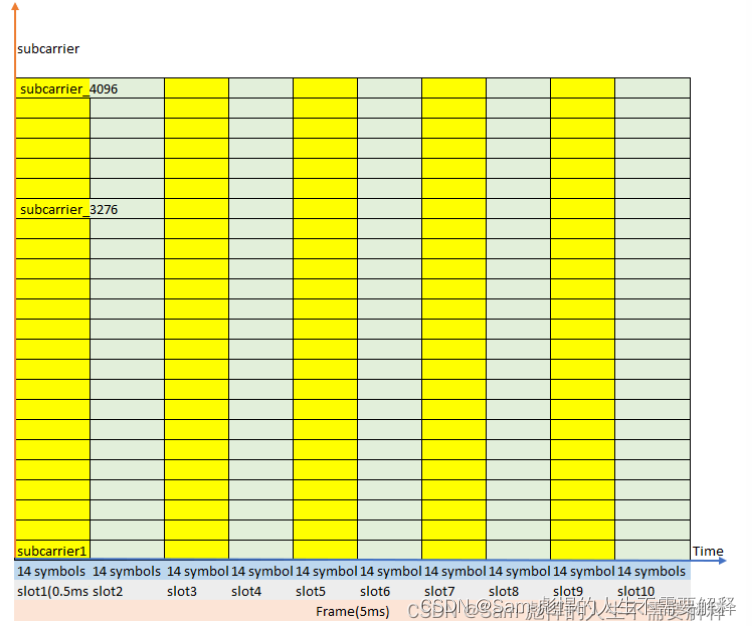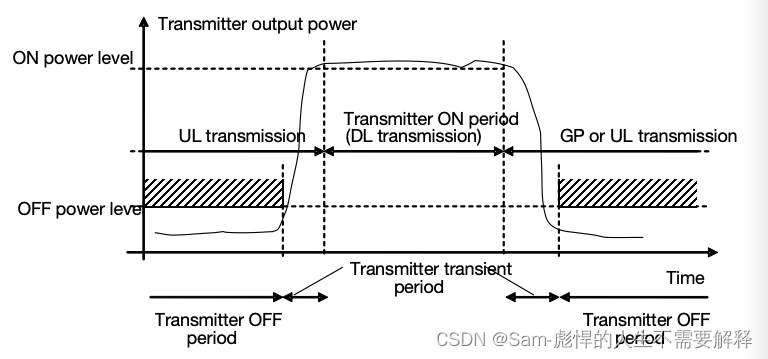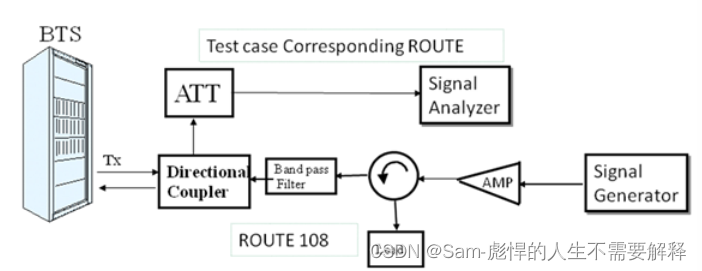5G_射频测试_发射机测量(四)
6.2 Base station output power
用于测量载波发射功率的大小,功率越大小区半径越大但是杂散也会越大
- 载波功率(用频谱仪测)
- 天线口功率(用功率计测)
- 载波功率是以RBW为单位的filter测量的积分功率
- 不同带宽的多载波测试时分为同样的功率谱密度或者每个再多带宽平衡

6.3.2 RE power control dynamic range
用于测量功率在最大和最小RE(resource?element)的信号质量,check?EVM的结果
最小setup?TM2/最大TM1.1/TM3.1的平均值(遍历每种调制方式),因为在测试EVM时最cover到RE的结果所以一般情况下不会单独测试这个case。
6.3 Output power dynamics
the difference between the maximum(TM3.1满PRB)?and the minimum transmit power(TM2只有一个PRB)RE的资源快:众坐标是频域 以subcarrier为单位一个PRB有12个subcarrier,横坐标:以时间symbol为单位 
带宽越大RE数量越多所以要求不一样(以100M有273个PRB为例:10*Log(273)=24.36dB)
Table 6.3.3.2-1: Total power dynamic range
| BS channel | Total power dynamic range (dB) | ||
| bandwidth?(MHz) | 15?kHz SCS | 30?kHz SCS | 60?kHz SCS |
| 20 | 20.2 | 17 | 13.8 |
| 50 | 24.3 | 21.2 | 18.1 |
| 100 | N/A | 24.3 | 21.3 |
6.4 Transmit ON/OFF power(只有TDD?模式需要测试)
- 在TX/RX?切换时
- 测量PA开和关的功率差
- 测试PA开关和关开所花的时间(5G要求10usà?因为3GPP规定了UL要提前DL?13us开始,LTE的要求上行提前下行20us所以这个case要求达到17us)
- 这个测试对测试仪表要求较高(keysight两次测量开功率和关功率和罗德一次性测试所以对测试环境和仪表的动态范围要求较高)
| Transition | Transient period length (μs) |
| OFF to ON | 10 |
| ON to OFF | 10 |

6.5 Transmitted signal quality
典型的信号质量case,需要测试不同的调制方式和不同的功率
| Modulation scheme for PDSCH | Required EVM |
| QPSK | 17.5 % |
| 16QAM | 12.5 % |
| 64QAM | 8 % |
| 256QAM | 3.5 % |
| 1024QAM | 2.5 %1 2.8 %2 |
| Note1: This requirement is applicable for frequencies equal to or below 4.2 GHz. Note 2: This requirement is applicable for frequencies above 4.2 GHz. | |
6.5.3 Time alignment error
This requirement shall apply to frame timing in MIMO transmission, carrier aggregation?and their combinations.
For MIMO transmission, at each carrier frequency, TAE shall not exceed 65 ns.
For intra-band contiguous carrier aggregation, with or without MIMO, TAE shall not exceed 260ns.
For intra-band non-contiguous carrier aggregation, with or without MIMO, TAE shall not exceed 3μs.
For inter-band carrier aggregation, with or without MIMO, TAE shall not exceed 3μs.
The time alignment error requirements for NB-IoT are specified in TS 36.104 [13] clause 6.5.3.
- 为了保证各个天线之间的timing?offset
- RRU的delay测试是保证这个case的前提
- 测试方法分
- 为合路所以测试天线但信号是mimo信号连接到频谱仪直接解调
- 单个天线分别解调那么测试信号就可以用普通Test?mode信号
6.6 Unwanted emissions(不想要的杂散信号就是那些会干扰别的设备的信号测量)
6.6.2 Occupied bandwidth
- 测量占用的带宽不能太大,超出定义带宽
- 99%的能量所占用的带宽
- 仪表从中心频点开始计算直到功率达到99%之后得到带宽大小
6.6.3 Adjacent Channel Leakage Power Ratio (ACLR)
- 测量有多少能量泄露到了相邻或者次邻道的信号,可能对别的小区的干扰
- 载波功率-邻道功率(积分功率)
- 更具带宽,基站类型要求不一样
- 当两个载波不相邻时需要考虑两个载波之间累积的泄露功率(CACLR)
- DPD?就是为了控制载波以为的功率所以DPD飞了就是说的ACLR的翅膀变高了
Table 6.6.3.5.2-1: Base station ACLR limit
| BS channel bandwidth?of lowest/highest NR carrier?transmitted BWChannel?(MHz) | BS adjacent channel centre frequency offset below the lowest or above the highest carrier centre frequency transmitted | Assumed adjacent channel carrier (informative) | Filter on the adjacent channel frequency and corresponding filter bandwidth | ACLR limit |
| 5, 10, 15, 20 | BWChannel | NR of same BW (Note 2) | Square (BWConfig) | 44.2 dB |
| 2 x BWChannel | NR of same BW (Note 2) | Square (BWConfig) | 44.2 dB | |
| BWChannel /2 + 2.5 MHz | 5 MHz E-UTRA | Square (4.5 MHz) | 44.2 dB (NOTE 3) | |
| BWChannel /2 + 7.5 MHz | 5 MHz E-UTRA | Square (4.5 MHz) | 44.2 dB?(NOTE 3) | |
| 25, 30, 40, 50, 60, 70, 80, 90, 100 | BWChannel | NR of same BW (Note 2) | Square (BWConfig) | 43.8 dB |
| 2 x BWChannel | NR of same BW (Note 2) | Square (BWConfig) | 43.8 dB | |
| BWChannel /2 + 2.5 MHz | 5 MHz E-UTRA | Square (4.5 MHz) | 43.8 dB (NOTE 3) | |
| BWChannel /2 + 7.5 MHz | 5 MHz E-UTRA | Square (4.5 MHz) | 43.8 dB?(NOTE 3) | |
| NOTE 1: BWChannel?and BWConfig?are the BS channel bandwidth?and transmission bandwidth configuration of the lowest/highest NR?carrier transmitted on the assigned channel frequency. NOTE 2: With SCS that provides largest transmission bandwidth configuration (BWConfig). NOTE 3: The requirements are applicable when the band is also defined for E-UTRA or UTRA. | ||||
The ACLR absolute basic limit?is specified in table?6.6.3.5.22.
Table 6.6.3.5.2-2: Base station ACLR absolute basic limit
| BS category / BS class | ACLR absolute basic limit |
| Category A Wide Area BS | -13 dBm/MHz |
| Category B Wide Area BS | -15 dBm/MHz |
| Medium Range BS | -25 dBm/MHz |
| Local Area BS | -32 dBm/MHz |
6.6.4 Operating band unwanted emissions(OBUE)
测量的目的和ACLR一样但是OBUE不是测的积分功率,它在要求特定的RBW下测试功率泄露的burst,所以RBW一般都很小例如100Khz
Table 6.6.4.5.2-3: Wide Area BS operating band?unwanted emission limits
(NR bands >3GHz) for Category A
| Frequency offset of measurement filter 3dB point, Df | Frequency offset of measurement filter centre frequency, f_offset | Basic limit?(Note 1, 2) | Measurement bandwidth |
| 0 MHz £?Df < 5 MHz | 0.05 MHz £?f_offset < 5.05 MHz |
| 100 kHz |
| 5 MHz £?Df < min(10 MHz, Dfmax) | 5.05 MHz £?f_offset < min(10.05 MHz, f_offsetmax) | -12.2 dBm | 100 kHz |
| 10 MHz £?Df £?Dfmax | 10.5 MHz £?f_offset < f_offsetmax? | -13 dBm (Note 3) | 1MHz |
| NOTE 1: For a BS supporting non-contiguous spectrum operation within any operating band, the emission limits within sub-block gaps is calculated as a cumulative sum of contributions from adjacent sub blocks on each side of the sub block gap, where the contribution from the far-end sub-block shall be scaled according to the measurement bandwidth of the near-end sub-block. Exception is Df ≥ 10MHz from both adjacent sub blocks on each side of the sub-block gap, where the emission limits within sub-block gaps shall be 13?dBm/1?MHz. NOTE 2: For a multi-band connector?with Inter RF Bandwidth gap < 2*ΔfOBUE?the emission limits within the Inter RF Bandwidth gaps is calculated as a cumulative sum of contributions from adjacent sub-blocks or RF Bandwidth on each side of the Inter RF Bandwidth gap, where the contribution from the far-end sub-block or RF Bandwidth shall be scaled according to the measurement bandwidth of the near-end sub-block or RF Bandwidth. NOTE 3: The requirement is not applicable when Dfmax?< 10 MHz. | |||
6.6.5 Transmitter spurious emissions(杂散)
杂散测试同样也是测试泄露到载波以外的能量,和ACLR、OBUE的不同之处在于
- ACLR?测试到了相邻和次相邻信道,并且是积分功率
- OBUE测试频带相对于载波的频率也是接近的一般在几十M或者一两百M以内,和杂散一样也指定RBW(不是积分功率)
- 杂散需要测试全频带的功率泄露(一般至少要求到5倍的谐波频带以内)
最基本的要求:
Table 6.6.5.5.1.1-2: General BS transmitter spurious emission limits in FR1, Category B
| Spurious frequency range | Basic limit | Measurement bandwidth | Notes |
| 9 kHz – 150 kHz | 1 kHz | Note 1, Note 4 | |
| 150 kHz – 30 MHz | -36 dBm | 10 kHz | Note 1, Note 4 |
| 30 MHz – 1 GHz | 100 kHz | Note 1 | |
| 1 GHz – 12.75 GHz | -30 dBm | 1 MHz | Note 1, Note 2 |
| 12.75 GHz – 5th?harmonic of the upper frequency edge of the DL operating band?in GHz | 1 MHz | Note 1, Note 2, Note 3 |
6.6.5.5.1.2 Protection of the BS receiver of own or different BS
对于FDD模式下测试对自己接收频段的保护能力
Table 6.6.5.5.1.2-1: BS spurious emissions basic limits?for protection of the BS receiver
| BS class | Frequency range | Basic limit | Measurement bandwidth |
| Wide Area BS | -96 dBm | ||
| Medium Range BS | FUL_low?– FUL_high | -91 dBm | 100 kHz |
| Local Area BS | -88 dBm |
co-existence with systems operating in other frequency bands
| System type for NR to co-exist with | Frequency range for co-existence requirement | Basic limit | Measurement bandwidth |
| GSM900 | 921 – 960 MHz | -57 dBm | 100 kHz |
| 876 – 915 MHz | -61 dBm | 100 kHz | |
| DCS1800 | 1805 – 1880 MHz | -47 dBm | 100 kHz |
| 1710 – 1785 MHz | -61 dBm | 100 kHz | |
| PCS1900 | 1930 – 1990 MHz | -47 dBm | 100 kHz |
| 1850 – 1910 MHz | -61 dBm | 100 kHz | |
| GSM850 or CDMA850 | 869 – 894 MHz | -57 dBm | 100 kHz |
| 824 – 849 MHz | -61 dBm | 100 kHz | |
| UTRA FDD Band I or | 2110 – 2170 MHz | -52 dBm | 1 MHz |
| E-UTRA Band 1 or NR Band n1 | 1920 – 1980 MHz | -49 dBm | 1 MHz |
6.6.5.5.1.4 Co-location with other base stations
These requirements may be applied for the protection of other BS receivers?co-located with a BS.
The requirements assume a 30?dB coupling loss?between transmitter and receiver and are based on co-location with base stations of the same class.
| Type of co-located BS | Frequency range for | Basic limit | Measurement | Note | ||
| co-location requirement | WA BS | MR BS | LA BS | bandwidth | ||
| GSM900 | 876-915 MHz | -98 dBm | -91 dBm | -70 dBm | 100 kHz | |
| DCS1800 | 1710 – 1785 MHz | -98 dBm | -91 dBm | -80 dBm | 100 kHz | |
| PCS1900 | 1850 – 1910 MHz | -98 dBm | -91 dBm | -80 dBm | 100 kHz | |
| GSM850 or CDMA850 | 824 – 849 MHz | -98 dBm | -91 dBm | -70 dBm | 100 kHz | |
| UTRA FDD Band I or E-UTRA Band 1 or NR Band n1 | 1920 – 1980 MHz | -96 dBm | -91 dBm | -88 dBm | 100 kHz | |
6.7 Transmitter intermodulation
- 互调测试模拟基站附近有个其他的基站或设备辐射出大功率,而待测的基站由于天线、天线接头、滤波器、低噪放、滤波器等器件的非线性生成了新的杂散信号,那么我们就需要测试生成的杂散信号是否满足上面unwanted?emission的要求(ACLR/OBUE/SE categoryB/co-existing/co-location所有要求)
- TDD?模式需要在DL时隙测试
- 测试环境的搭建要求较高

本文来自互联网用户投稿,该文观点仅代表作者本人,不代表本站立场。本站仅提供信息存储空间服务,不拥有所有权,不承担相关法律责任。 如若内容造成侵权/违法违规/事实不符,请联系我的编程经验分享网邮箱:chenni525@qq.com进行投诉反馈,一经查实,立即删除!
- Python教程
- 深入理解 MySQL 中的 HAVING 关键字和聚合函数
- Qt之QChar编码(1)
- MyBatis入门基础篇
- 用Python脚本实现FFmpeg批量转换
- 【Amazon 实验②】Amazon WAF功能增强之使用Cloudfront、Lambda@Edge阻挡攻击
- 【OCR】 - Tesseract OCR在Windows系统中安装
- WebSocket ACK 协议解析:最大限度提高通信可靠性
- UE中使用Niagara粒子构建空间网格类特效
- 【OpenGL/WebGL】Shader中如何获取摄像机视口的宽高
- common-pool的GenericObjectPool源码创建borrowObject方法研读
- Fog-Aware Adaptive YOLO for Object Detection in Adverse Weather
- 大前端nestjs入门教程系列(四):如何nestjs整合mysql数据库
- 四川古力未来科技有限公司抖音小店:开启未来商业新篇章
- L1-075:强迫症
